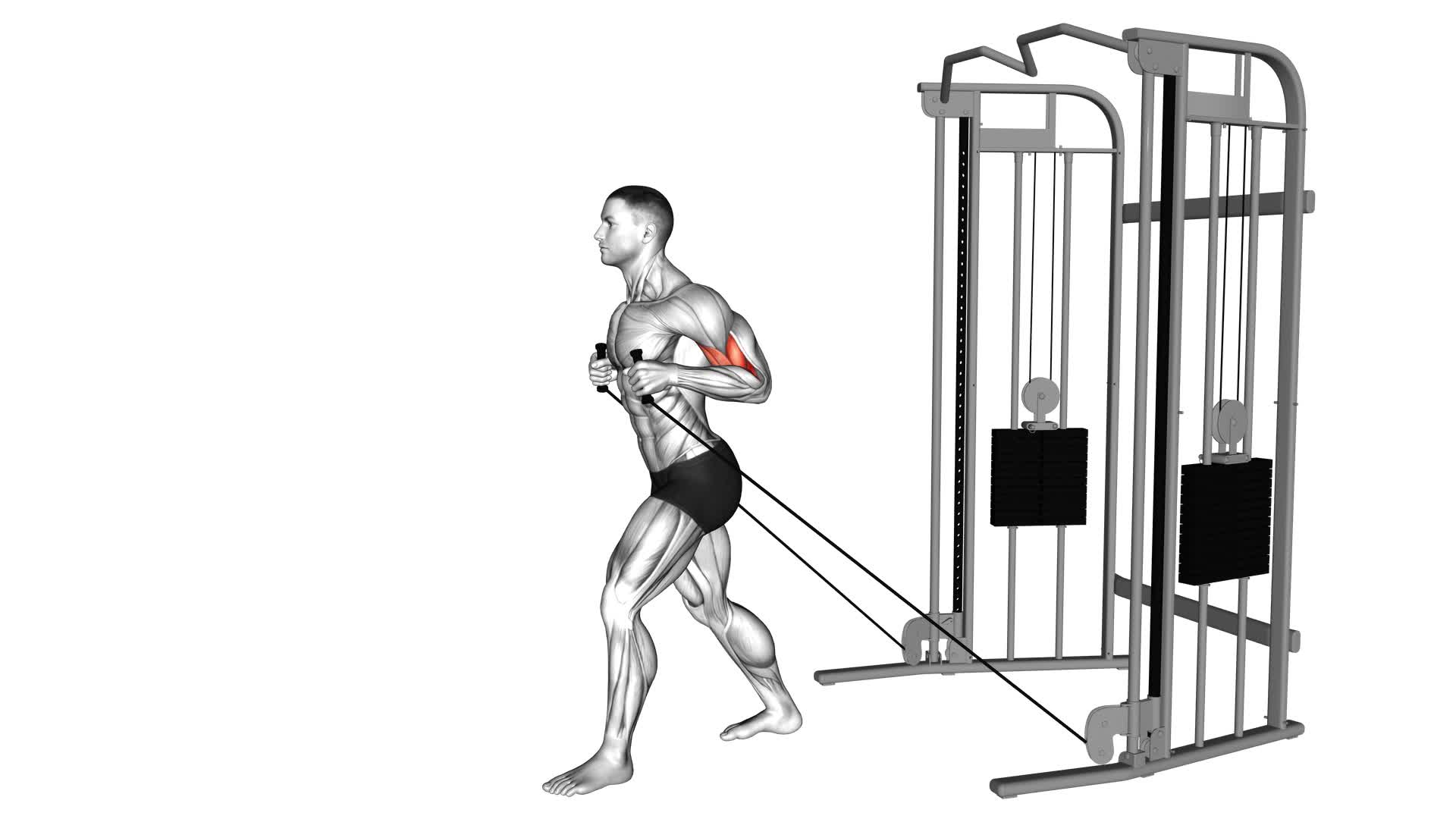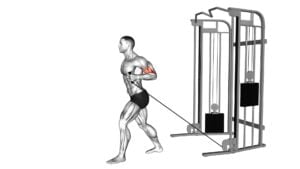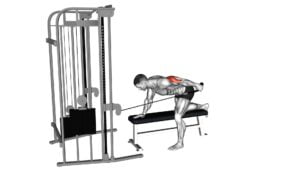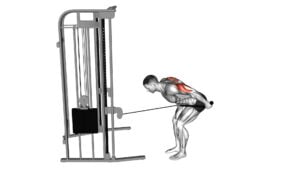Cable Neutral Grip Biceps Curl – Video Exercise Guide & Tips

Are you looking to tone and strengthen your biceps?
Watch This Exercise Video
The Cable Neutral Grip Biceps Curl is the perfect exercise for you.
In this video exercise guide, we'll show you the proper form and technique, as well as variations to target different areas of your biceps.
Avoid common mistakes and maximize the effectiveness of this exercise with our helpful tips.
Get ready to achieve those sculpted arms you've always wanted!
Key Takeaways
- Targets biceps effectively by engaging the brachialis muscle
- Provides a greater range of motion compared to other biceps exercises
- Puts less strain on wrists and elbows
- Helps improve grip strength
Benefits of the Cable Neutral Grip Biceps Curl
You can experience several benefits from incorporating the cable neutral grip biceps curl into your workout routine.
One of the main advantages of this exercise is that it targets the biceps muscles effectively. By using the neutral grip, with your palms facing each other, you engage the brachialis muscle, which lies underneath the biceps. This helps to develop overall arm strength and size.
Another benefit is that the cable neutral grip biceps curl allows for a greater range of motion compared to other biceps exercises. The cables provide constant tension throughout the movement, ensuring that the biceps are fully engaged from start to finish.
Additionally, this exercise puts less strain on the wrists and elbows compared to exercises like the barbell curl. This makes it a suitable option for individuals with wrist or elbow issues.
Moreover, the cable neutral grip biceps curl can help improve grip strength, as you need to hold onto the handles while performing the exercise.
By incorporating this exercise into your routine, you can experience these benefits and more.
Now, let's move on to discussing the proper form and technique for the exercise.
Proper Form and Technique for the Exercise
To perform the cable neutral grip biceps curl with proper form and technique, ensure that you maintain a stable stance and grip the handles firmly. Start by standing with your feet shoulder-width apart and your knees slightly bent. This will provide a solid foundation and help you maintain balance throughout the exercise. As you grip the handles, make sure your palms are facing each other in a neutral position.
One common error to avoid is using momentum to lift the weight. Instead, focus on using your biceps to control the movement. Keep your elbows close to your sides and avoid swinging them forward or backward. This will ensure that your biceps are properly activated and engaged throughout the exercise.
Another common mistake isn't fully extending the arms at the bottom of the movement. To maximize muscle activation, make sure to fully straighten your arms at the starting position and squeeze your biceps at the top of the movement. This will help you get the most out of each repetition and build strength in your biceps.
Variations to Target Different Areas of the Biceps
To further optimize your biceps workout, how can you modify the cable neutral grip biceps curl to target different areas of your biceps? There are a few variations you can incorporate into your routine to activate different muscles within the biceps.
One alternative is the hammer curl, where you perform the curl with a neutral grip, just like the cable neutral grip biceps curl. However, instead of keeping your palms facing up, you keep them facing each other throughout the movement. This targets the brachialis muscle, which lies underneath the biceps and helps to add thickness to the overall arm.
Another variation is the reverse curl. In this exercise, you hold the barbell or dumbbells with an overhand grip, palms facing down. By doing so, you shift the emphasis to the brachioradialis muscle, located on the outer part of the forearm. This variation helps to develop forearm strength and size while still engaging the biceps.
Incorporating these alternatives into your biceps workout can provide a well-rounded approach to targeting different areas of the biceps. By focusing on specific muscles, you can enhance overall muscle activation and achieve a more balanced and aesthetically pleasing bicep development.
Common Mistakes to Avoid During the Exercise
When performing the cable neutral grip biceps curl, it's important to be aware of common mistakes that can hinder your progress and effectiveness of the exercise. One common mistake to avoid is using too much weight. It may be tempting to lift heavy to show off your strength, but using excessive weight can compromise your form and increase the risk of injury. It's crucial to choose a weight that allows you to maintain proper form throughout the entire movement.
Another common mistake is swinging the body. This often occurs when the weight is too heavy or when individuals are trying to use momentum to lift the weight. Swinging not only takes the focus away from the biceps, but it also puts unnecessary stress on the lower back and can lead to strain or injury. To prevent swinging, focus on keeping your upper body stable and engage your core muscles.
Additionally, improper grip can hinder the effectiveness of the exercise. Make sure to use a neutral grip with your palms facing each other. Avoid using a supinated (underhand) or pronated (overhand) grip, as these variations can shift the emphasis away from the biceps and onto other muscles.
Lastly, rushing through the exercise is a common mistake. It's important to perform the movement with control and focus on the muscle contraction. Take your time to lower the weight under control and squeeze your biceps at the top of the movement.
Tips for Maximizing the Effectiveness of the Cable Neutral Grip Biceps Curl
To maximize the effectiveness of the cable neutral grip biceps curl, focus on maintaining proper form and engaging your biceps throughout the entire movement. By following these tips, you can ensure maximum gains and muscle activation:
- Keep your elbows tucked in: Throughout the exercise, it's important to keep your elbows close to your sides. This helps isolate the biceps and prevents the shoulders from assisting in the movement.
- Squeeze at the top: When you reach the top of the curl, squeeze your biceps for a brief moment before slowly lowering the weight. This contraction at the top of the movement enhances muscle activation and stimulates growth.
- Control the eccentric phase: The eccentric phase refers to the lowering of the weight. Instead of allowing the weight to drop quickly, focus on controlling the descent. This creates more tension in the biceps, leading to greater muscle activation and gains.
Frequently Asked Questions
How Many Sets and Reps Should I Perform for the Cable Neutral Grip Biceps Curl?
To properly perform the cable neutral grip biceps curl, it's important to determine the number of sets and reps that suit your fitness level and goals.
The recommended starting point is 3 sets of 10-12 reps.
As you progress, you can increase the intensity by adding more weight or performing additional sets.
Keep in mind to maintain proper form and listen to your body to avoid injury.
Can the Cable Neutral Grip Biceps Curl Help in Building Forearm Strength?
Yes, the cable neutral grip biceps curl can help in building forearm strength. This exercise targets both the biceps and the forearm muscles, providing a comprehensive workout for your upper body.
The cable resistance allows for consistent tension throughout the movement, maximizing muscle activation and growth. Incorporating cable exercises into your routine offers several benefits, including increased stability, improved grip strength, and enhanced muscle definition.
Is It Necessary to Warm up Before Performing the Cable Neutral Grip Biceps Curl?
Before performing the cable neutral grip biceps curl, warming up is highly recommended. A warm-up routine helps prepare your muscles for the exercise, reducing the risk of injury and enhancing performance.
It increases blood flow, flexibility, and range of motion in your arms, ensuring that you can execute the exercise with proper form and technique.
Can the Cable Neutral Grip Biceps Curl Be Performed Using Dumbbells Instead of a Cable Machine?
Yes, you can perform the cable neutral grip biceps curl using dumbbells instead of a cable machine. However, using a cable machine offers some benefits for biceps development.
The cable machine provides constant tension throughout the entire range of motion, targeting the biceps effectively. Additionally, the neutral grip position reduces strain on the wrists and forearms.
But if you don't have access to a cable machine, dumbbells can still be a good alternative for working your biceps.
Are There Any Specific Stretches or Exercises That Can Complement the Cable Neutral Grip Biceps Curl for Overall Arm Development?
To complement the cable neutral grip biceps curl and develop your arms overall, there are specific stretches and exercises you can do.
Two great options are hammer curls and tricep dips. Hammer curls target your biceps brachii and brachialis, while tricep dips work your triceps.
Incorporating these exercises into your routine will help you achieve well-rounded arm development.
Additionally, don't forget to stretch your arms before and after your workout to improve flexibility and prevent injury.
Conclusion
In conclusion, the Cable Neutral Grip Biceps Curl is a highly effective exercise for targeting the biceps muscles. By maintaining proper form and technique, individuals can maximize the benefits of this exercise and avoid common mistakes.
Additionally, incorporating variations of this exercise can help target different areas of the biceps for a well-rounded workout.
With these tips in mind, individuals can optimize the effectiveness of the Cable Neutral Grip Biceps Curl and enhance their arm strength and muscle development.

Author
Years ago, the spark of my life’s passion ignited in my mind the moment I stepped into the local gym for the first time. The inaugural bead of perspiration, the initial endeavor, the very first surge of endorphins, and a sense of pride that washed over me post-workout marked the beginning of my deep-seated interest in strength sports, fitness, and sports nutrition. This very curiosity blossomed rapidly into a profound fascination, propelling me to earn a Master’s degree in Physical Education from the Academy of Physical Education in Krakow, followed by a Sports Manager diploma from the Jagiellonian University. My journey of growth led me to gain more specialized qualifications, such as being a certified personal trainer with a focus on sports dietetics, a lifeguard, and an instructor for wellness and corrective gymnastics. Theoretical knowledge paired seamlessly with practical experience, reinforcing my belief that the transformation of individuals under my guidance was also a reflection of my personal growth. This belief holds true even today. Each day, I strive to push the boundaries and explore new realms. These realms gently elevate me to greater heights. The unique combination of passion for my field and the continuous quest for growth fuels my drive to break new ground.







